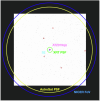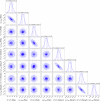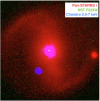Quasi-periodic X-ray eruptions years after a nearby tidal disruption event
- PMID: 39385028
- PMCID: PMC11499261
- DOI: 10.1038/s41586-024-08023-6
Quasi-periodic X-ray eruptions years after a nearby tidal disruption event
Abstract
Quasi-periodic eruptions (QPEs) are luminous bursts of soft X-rays from the nuclei of galaxies, repeating on timescales of hours to weeks1-5. The mechanism behind these rare systems is uncertain, but most theories involve accretion disks around supermassive black holes (SMBHs) undergoing instabilities6-8 or interacting with a stellar object in a close orbit9-11. It has been suggested that this disk could be created when the SMBH disrupts a passing star8,11, implying that many QPEs should be preceded by observable tidal disruption events (TDEs). Two known QPE sources show long-term decays in quiescent luminosity consistent with TDEs4,12 and two observed TDEs have exhibited X-ray flares consistent with individual eruptions13,14. TDEs and QPEs also occur preferentially in similar galaxies15. However, no confirmed repeating QPEs have been associated with a spectroscopically confirmed TDE or an optical TDE observed at peak brightness. Here we report the detection of nine X-ray QPEs with a mean recurrence time of approximately 48 h from AT2019qiz, a nearby and extensively studied optically selected TDE16. We detect and model the X-ray, ultraviolet (UV) and optical emission from the accretion disk and show that an orbiting body colliding with this disk provides a plausible explanation for the QPEs.
© 2024. The Author(s).
Conflict of interest statement
The authors declare no competing interests.
Figures













References
-
- Miniutti, G. et al. Nine-hour X-ray quasi-periodic eruptions from a low-mass black hole galactic nucleus. Nature573, 381–384 (2019). - PubMed
-
- Giustini, M., Miniutti, G. & Saxton, R. D. X-ray quasi-periodic eruptions from the galactic nucleus of RX J1301.9+2747. Astron. Astrophys.636, L2 (2020).
-
- Arcodia, R. et al. The more the merrier: SRG/eROSITA discovers two further galaxies showing X-ray quasi-periodic eruptions. Astron. Astrophys.684, A64 (2024).
-
- Guolo, M. et al. X-ray eruptions every 22 days from the nucleus of a nearby galaxy. Nat. Astron.8, 347–358 (2024).

